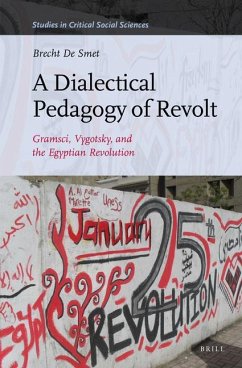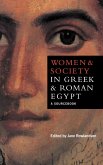- Gebundenes Buch
- Merkliste
- Auf die Merkliste
- Bewerten Bewerten
- Teilen
- Produkt teilen
- Produkterinnerung
- Produkterinnerung
In A Dialectical Pedagogy of Revolt Brecht De Smet integrates the political thought of Antonio Gramsci with the cultural psychology of Lev Vygotsky into an original perspective on revolutionary subjectivity that is deployed to understand the Egyptian "Tahrir" Revolution.
Andere Kunden interessierten sich auch für
![Niebuhr in Egypt Niebuhr in Egypt]() Roger H. Jr. GuichardNiebuhr in Egypt45,99 €
Roger H. Jr. GuichardNiebuhr in Egypt45,99 €![The Dimensions of Hegemony The Dimensions of Hegemony]() Craig BrandistThe Dimensions of Hegemony187,99 €
Craig BrandistThe Dimensions of Hegemony187,99 €![Resilience and the Brown Babe's Burden Resilience and the Brown Babe's Burden]() Resilience and the Brown Babe's Burden148,99 €
Resilience and the Brown Babe's Burden148,99 €![Parliaments and Parties in Egypt Parliaments and Parties in Egypt]() Jacob M LandauParliaments and Parties in Egypt202,99 €
Jacob M LandauParliaments and Parties in Egypt202,99 €![Women and Society in Greek and Roman Egypt Women and Society in Greek and Roman Egypt]() Jane Rowlandson (ed.)Women and Society in Greek and Roman Egypt161,99 €
Jane Rowlandson (ed.)Women and Society in Greek and Roman Egypt161,99 €![Fitting In, Standing Out Fitting In, Standing Out]() Robert CrosnoeFitting In, Standing Out38,99 €
Robert CrosnoeFitting In, Standing Out38,99 €![Queer Girls in Class Queer Girls in Class]() Queer Girls in Class105,95 €
Queer Girls in Class105,95 €-
-
-
In A Dialectical Pedagogy of Revolt Brecht De Smet integrates the political thought of Antonio Gramsci with the cultural psychology of Lev Vygotsky into an original perspective on revolutionary subjectivity that is deployed to understand the Egyptian "Tahrir" Revolution.
Hinweis: Dieser Artikel kann nur an eine deutsche Lieferadresse ausgeliefert werden.
Hinweis: Dieser Artikel kann nur an eine deutsche Lieferadresse ausgeliefert werden.
Produktdetails
- Produktdetails
- Verlag: Brill
- Seitenzahl: 440
- Erscheinungstermin: 20. Januar 2015
- Englisch
- Abmessung: 239mm x 163mm x 28mm
- Gewicht: 780g
- ISBN-13: 9789004262652
- ISBN-10: 9004262652
- Artikelnr.: 41648997
- Herstellerkennzeichnung
- Libri GmbH
- Europaallee 1
- 36244 Bad Hersfeld
- gpsr@libri.de
- Verlag: Brill
- Seitenzahl: 440
- Erscheinungstermin: 20. Januar 2015
- Englisch
- Abmessung: 239mm x 163mm x 28mm
- Gewicht: 780g
- ISBN-13: 9789004262652
- ISBN-10: 9004262652
- Artikelnr.: 41648997
- Herstellerkennzeichnung
- Libri GmbH
- Europaallee 1
- 36244 Bad Hersfeld
- gpsr@libri.de
Brecht De Smet, Ph.D. (2012), Ghent University, is a post-doctoral researcher and lecturer at that university. He has published on Gramsci, subject formation, and the Egyptian workers' movement, including "Revolution and Counter-Revolution in Egypt" (Science & Society 78(1), 2014).
Foreword by Andy Blunden
Preface
Acknowledgments
Abbreviations
Introduction
PART I: SUBJECT AND ACTIVITY
1. In Want of the People
People and Population
The People and the Régime
2. Individual and Collective
Mind and Body
Transcendental Subject
Activity
Collective Subjectivity
3. Concept of the Subject
Gestalt, Bildung, Urphänomen
Formation of Consciousness, Concept
Practical-Critical Activity
Social Formation, Cell-Form
4. Cultural-Historical Activity Theory
Unit of Analysis
Learning and Development
Activity as Collaboration
Conclusions
PART II: SUBJECT AND STRUGGLE
5. Class as Subject
Political and Human Emancipation
The Proletariat as Subject
Actual and Logical Development
6. The Modern Prince
The Strike as Cell-Form
Trade Unionism
The Economic and the Political
Demonstration and Party
Proletarian Hegemony
7. A Pedagogy of Revolt
Learning and Instruction
Philosophy of Praxis
Intellectuals and Assistance
8. Revolution
Growth and Crisis
Revolution
The Mass Strike
Movement, Position, Underground
9. Pathologies
Iron Law of Oligarchy?
Revolution-Restoration
Inadequate Instruction
Substitutionism
PART III: HISTORICAL LINEAGES
10. Roots of the 25 January Uprising
Surprised by the Expected
Original Accumulation and Extended Reproduction
Uneven and Combined Development
Permanent Revolution
11. Colonial Subjects
At the Doorstep of Capitalism
A Colonial Historical Bloc
Development of the Strike
Revolution
12. Colonial Crisis
Dependent Development
The Road to Trade Unionism
The Muslim Brotherhood
The Second Wave of Communism
Organic Crisis
13. Nasserism
The Nasserist Intervention
Escaping Colonialism
Officers and Workers
The Concept of Nasserism
A Caesarist Pathology
PART IV: NEOLIBERAL CAPITALISM
14. Sadat's Infitah
Crisis of Nasserism
Capitalist Offensive
Strikes and Demonstrations
Islamic Fascism?
Crisis and Defeat
15. Mubarak's Détente
Politics of a Rentier Economy
Absorption of the Brotherhood
Absorption of the Left
Absorption of the Workers
16. Neoliberal War of Movement
Neoliberal Counter-Reform
Subordinating the Subaltern
Subordinating the Elites
17. The Civildemocratic Project
Crisis of the 'Legal Left'
A New Left
Rise of Street Politics
Brothers and Comrades
The End of the Political Line
PART V: THE WORKERS' MOVEMENT
18. The Mahalla Strikes
Ghazl al-Mahalla
On the Offensive
Insurrection
19. Development of the Strike
Systematization
Interiorization
Projection
Mahalla's Defeat
The First Independent Trade Union
Snowball Trade Unionism
20. The Strike's Intellectuals
Organic Intellectuals
A Return to Class
The Old Left
The New Left
Muslim Brothers
Journalists
Artists
Human Rights Activists
21. Pedagogies of Revolt
Forms of Assistance
Modes of Assistance
Colonization
Commodification
Solidarity
Educating the Educators
22. Adequate Assistance
Boundaries of Instruction
Limits of the Economic Line
Limits of the Political Line
PART VI: TAHRIR
23. Story of an Uprising (I)
The Tension Mounts
Tunisian Prolepsis
25 January
Keeping the Fire Going
Friday of Anger
24. Story of an Uprising (II)
Gaining Confidence
Battle of the Camel
Remaining Steadfast
Day of Departure
25. The Activity of Tahrir
Extended Reproduction
Demonstration
Occupation
The Whip of Counterrevolution
26. the Organization of Tahrir
Spontaneous Organization
Technical Assistance
Cultural Instruction
Leadership
Immanence and Teleology
Projection
27. The Mass Strike
Workers as National-Popular Actors
Workers as Class Actors
The Economic and the Political
28. Revolutionary Pathologies
Lack of a Center
Caesarism Again?
The End of the People
Soviets?
29. Revolution beyond Tahrir
From Cell-Form to Symbol
A Civil Counterrevolution
Popular Uprising and Military Coup
Many Princes
Popular or Proletarian?
CONCLUSIONS
Permanent Deflections of Revolution
Class Formation and Anti-Imperialism
Independent Trade Unionism
Nasserist Deflection
Neoliberal War of Movement
Uprising and Deflection
A Pedagogy of Revolt
Interiorization
Forms and Modes of Assistance
Zone of Proximal Development
A Self-Reflecting Note
References
Interviews
Literature
Index
Preface
Acknowledgments
Abbreviations
Introduction
PART I: SUBJECT AND ACTIVITY
1. In Want of the People
People and Population
The People and the Régime
2. Individual and Collective
Mind and Body
Transcendental Subject
Activity
Collective Subjectivity
3. Concept of the Subject
Gestalt, Bildung, Urphänomen
Formation of Consciousness, Concept
Practical-Critical Activity
Social Formation, Cell-Form
4. Cultural-Historical Activity Theory
Unit of Analysis
Learning and Development
Activity as Collaboration
Conclusions
PART II: SUBJECT AND STRUGGLE
5. Class as Subject
Political and Human Emancipation
The Proletariat as Subject
Actual and Logical Development
6. The Modern Prince
The Strike as Cell-Form
Trade Unionism
The Economic and the Political
Demonstration and Party
Proletarian Hegemony
7. A Pedagogy of Revolt
Learning and Instruction
Philosophy of Praxis
Intellectuals and Assistance
8. Revolution
Growth and Crisis
Revolution
The Mass Strike
Movement, Position, Underground
9. Pathologies
Iron Law of Oligarchy?
Revolution-Restoration
Inadequate Instruction
Substitutionism
PART III: HISTORICAL LINEAGES
10. Roots of the 25 January Uprising
Surprised by the Expected
Original Accumulation and Extended Reproduction
Uneven and Combined Development
Permanent Revolution
11. Colonial Subjects
At the Doorstep of Capitalism
A Colonial Historical Bloc
Development of the Strike
Revolution
12. Colonial Crisis
Dependent Development
The Road to Trade Unionism
The Muslim Brotherhood
The Second Wave of Communism
Organic Crisis
13. Nasserism
The Nasserist Intervention
Escaping Colonialism
Officers and Workers
The Concept of Nasserism
A Caesarist Pathology
PART IV: NEOLIBERAL CAPITALISM
14. Sadat's Infitah
Crisis of Nasserism
Capitalist Offensive
Strikes and Demonstrations
Islamic Fascism?
Crisis and Defeat
15. Mubarak's Détente
Politics of a Rentier Economy
Absorption of the Brotherhood
Absorption of the Left
Absorption of the Workers
16. Neoliberal War of Movement
Neoliberal Counter-Reform
Subordinating the Subaltern
Subordinating the Elites
17. The Civildemocratic Project
Crisis of the 'Legal Left'
A New Left
Rise of Street Politics
Brothers and Comrades
The End of the Political Line
PART V: THE WORKERS' MOVEMENT
18. The Mahalla Strikes
Ghazl al-Mahalla
On the Offensive
Insurrection
19. Development of the Strike
Systematization
Interiorization
Projection
Mahalla's Defeat
The First Independent Trade Union
Snowball Trade Unionism
20. The Strike's Intellectuals
Organic Intellectuals
A Return to Class
The Old Left
The New Left
Muslim Brothers
Journalists
Artists
Human Rights Activists
21. Pedagogies of Revolt
Forms of Assistance
Modes of Assistance
Colonization
Commodification
Solidarity
Educating the Educators
22. Adequate Assistance
Boundaries of Instruction
Limits of the Economic Line
Limits of the Political Line
PART VI: TAHRIR
23. Story of an Uprising (I)
The Tension Mounts
Tunisian Prolepsis
25 January
Keeping the Fire Going
Friday of Anger
24. Story of an Uprising (II)
Gaining Confidence
Battle of the Camel
Remaining Steadfast
Day of Departure
25. The Activity of Tahrir
Extended Reproduction
Demonstration
Occupation
The Whip of Counterrevolution
26. the Organization of Tahrir
Spontaneous Organization
Technical Assistance
Cultural Instruction
Leadership
Immanence and Teleology
Projection
27. The Mass Strike
Workers as National-Popular Actors
Workers as Class Actors
The Economic and the Political
28. Revolutionary Pathologies
Lack of a Center
Caesarism Again?
The End of the People
Soviets?
29. Revolution beyond Tahrir
From Cell-Form to Symbol
A Civil Counterrevolution
Popular Uprising and Military Coup
Many Princes
Popular or Proletarian?
CONCLUSIONS
Permanent Deflections of Revolution
Class Formation and Anti-Imperialism
Independent Trade Unionism
Nasserist Deflection
Neoliberal War of Movement
Uprising and Deflection
A Pedagogy of Revolt
Interiorization
Forms and Modes of Assistance
Zone of Proximal Development
A Self-Reflecting Note
References
Interviews
Literature
Index
Foreword by Andy Blunden
Preface
Acknowledgments
Abbreviations
Introduction
PART I: SUBJECT AND ACTIVITY
1. In Want of the People
People and Population
The People and the Régime
2. Individual and Collective
Mind and Body
Transcendental Subject
Activity
Collective Subjectivity
3. Concept of the Subject
Gestalt, Bildung, Urphänomen
Formation of Consciousness, Concept
Practical-Critical Activity
Social Formation, Cell-Form
4. Cultural-Historical Activity Theory
Unit of Analysis
Learning and Development
Activity as Collaboration
Conclusions
PART II: SUBJECT AND STRUGGLE
5. Class as Subject
Political and Human Emancipation
The Proletariat as Subject
Actual and Logical Development
6. The Modern Prince
The Strike as Cell-Form
Trade Unionism
The Economic and the Political
Demonstration and Party
Proletarian Hegemony
7. A Pedagogy of Revolt
Learning and Instruction
Philosophy of Praxis
Intellectuals and Assistance
8. Revolution
Growth and Crisis
Revolution
The Mass Strike
Movement, Position, Underground
9. Pathologies
Iron Law of Oligarchy?
Revolution-Restoration
Inadequate Instruction
Substitutionism
PART III: HISTORICAL LINEAGES
10. Roots of the 25 January Uprising
Surprised by the Expected
Original Accumulation and Extended Reproduction
Uneven and Combined Development
Permanent Revolution
11. Colonial Subjects
At the Doorstep of Capitalism
A Colonial Historical Bloc
Development of the Strike
Revolution
12. Colonial Crisis
Dependent Development
The Road to Trade Unionism
The Muslim Brotherhood
The Second Wave of Communism
Organic Crisis
13. Nasserism
The Nasserist Intervention
Escaping Colonialism
Officers and Workers
The Concept of Nasserism
A Caesarist Pathology
PART IV: NEOLIBERAL CAPITALISM
14. Sadat's Infitah
Crisis of Nasserism
Capitalist Offensive
Strikes and Demonstrations
Islamic Fascism?
Crisis and Defeat
15. Mubarak's Détente
Politics of a Rentier Economy
Absorption of the Brotherhood
Absorption of the Left
Absorption of the Workers
16. Neoliberal War of Movement
Neoliberal Counter-Reform
Subordinating the Subaltern
Subordinating the Elites
17. The Civildemocratic Project
Crisis of the 'Legal Left'
A New Left
Rise of Street Politics
Brothers and Comrades
The End of the Political Line
PART V: THE WORKERS' MOVEMENT
18. The Mahalla Strikes
Ghazl al-Mahalla
On the Offensive
Insurrection
19. Development of the Strike
Systematization
Interiorization
Projection
Mahalla's Defeat
The First Independent Trade Union
Snowball Trade Unionism
20. The Strike's Intellectuals
Organic Intellectuals
A Return to Class
The Old Left
The New Left
Muslim Brothers
Journalists
Artists
Human Rights Activists
21. Pedagogies of Revolt
Forms of Assistance
Modes of Assistance
Colonization
Commodification
Solidarity
Educating the Educators
22. Adequate Assistance
Boundaries of Instruction
Limits of the Economic Line
Limits of the Political Line
PART VI: TAHRIR
23. Story of an Uprising (I)
The Tension Mounts
Tunisian Prolepsis
25 January
Keeping the Fire Going
Friday of Anger
24. Story of an Uprising (II)
Gaining Confidence
Battle of the Camel
Remaining Steadfast
Day of Departure
25. The Activity of Tahrir
Extended Reproduction
Demonstration
Occupation
The Whip of Counterrevolution
26. the Organization of Tahrir
Spontaneous Organization
Technical Assistance
Cultural Instruction
Leadership
Immanence and Teleology
Projection
27. The Mass Strike
Workers as National-Popular Actors
Workers as Class Actors
The Economic and the Political
28. Revolutionary Pathologies
Lack of a Center
Caesarism Again?
The End of the People
Soviets?
29. Revolution beyond Tahrir
From Cell-Form to Symbol
A Civil Counterrevolution
Popular Uprising and Military Coup
Many Princes
Popular or Proletarian?
CONCLUSIONS
Permanent Deflections of Revolution
Class Formation and Anti-Imperialism
Independent Trade Unionism
Nasserist Deflection
Neoliberal War of Movement
Uprising and Deflection
A Pedagogy of Revolt
Interiorization
Forms and Modes of Assistance
Zone of Proximal Development
A Self-Reflecting Note
References
Interviews
Literature
Index
Preface
Acknowledgments
Abbreviations
Introduction
PART I: SUBJECT AND ACTIVITY
1. In Want of the People
People and Population
The People and the Régime
2. Individual and Collective
Mind and Body
Transcendental Subject
Activity
Collective Subjectivity
3. Concept of the Subject
Gestalt, Bildung, Urphänomen
Formation of Consciousness, Concept
Practical-Critical Activity
Social Formation, Cell-Form
4. Cultural-Historical Activity Theory
Unit of Analysis
Learning and Development
Activity as Collaboration
Conclusions
PART II: SUBJECT AND STRUGGLE
5. Class as Subject
Political and Human Emancipation
The Proletariat as Subject
Actual and Logical Development
6. The Modern Prince
The Strike as Cell-Form
Trade Unionism
The Economic and the Political
Demonstration and Party
Proletarian Hegemony
7. A Pedagogy of Revolt
Learning and Instruction
Philosophy of Praxis
Intellectuals and Assistance
8. Revolution
Growth and Crisis
Revolution
The Mass Strike
Movement, Position, Underground
9. Pathologies
Iron Law of Oligarchy?
Revolution-Restoration
Inadequate Instruction
Substitutionism
PART III: HISTORICAL LINEAGES
10. Roots of the 25 January Uprising
Surprised by the Expected
Original Accumulation and Extended Reproduction
Uneven and Combined Development
Permanent Revolution
11. Colonial Subjects
At the Doorstep of Capitalism
A Colonial Historical Bloc
Development of the Strike
Revolution
12. Colonial Crisis
Dependent Development
The Road to Trade Unionism
The Muslim Brotherhood
The Second Wave of Communism
Organic Crisis
13. Nasserism
The Nasserist Intervention
Escaping Colonialism
Officers and Workers
The Concept of Nasserism
A Caesarist Pathology
PART IV: NEOLIBERAL CAPITALISM
14. Sadat's Infitah
Crisis of Nasserism
Capitalist Offensive
Strikes and Demonstrations
Islamic Fascism?
Crisis and Defeat
15. Mubarak's Détente
Politics of a Rentier Economy
Absorption of the Brotherhood
Absorption of the Left
Absorption of the Workers
16. Neoliberal War of Movement
Neoliberal Counter-Reform
Subordinating the Subaltern
Subordinating the Elites
17. The Civildemocratic Project
Crisis of the 'Legal Left'
A New Left
Rise of Street Politics
Brothers and Comrades
The End of the Political Line
PART V: THE WORKERS' MOVEMENT
18. The Mahalla Strikes
Ghazl al-Mahalla
On the Offensive
Insurrection
19. Development of the Strike
Systematization
Interiorization
Projection
Mahalla's Defeat
The First Independent Trade Union
Snowball Trade Unionism
20. The Strike's Intellectuals
Organic Intellectuals
A Return to Class
The Old Left
The New Left
Muslim Brothers
Journalists
Artists
Human Rights Activists
21. Pedagogies of Revolt
Forms of Assistance
Modes of Assistance
Colonization
Commodification
Solidarity
Educating the Educators
22. Adequate Assistance
Boundaries of Instruction
Limits of the Economic Line
Limits of the Political Line
PART VI: TAHRIR
23. Story of an Uprising (I)
The Tension Mounts
Tunisian Prolepsis
25 January
Keeping the Fire Going
Friday of Anger
24. Story of an Uprising (II)
Gaining Confidence
Battle of the Camel
Remaining Steadfast
Day of Departure
25. The Activity of Tahrir
Extended Reproduction
Demonstration
Occupation
The Whip of Counterrevolution
26. the Organization of Tahrir
Spontaneous Organization
Technical Assistance
Cultural Instruction
Leadership
Immanence and Teleology
Projection
27. The Mass Strike
Workers as National-Popular Actors
Workers as Class Actors
The Economic and the Political
28. Revolutionary Pathologies
Lack of a Center
Caesarism Again?
The End of the People
Soviets?
29. Revolution beyond Tahrir
From Cell-Form to Symbol
A Civil Counterrevolution
Popular Uprising and Military Coup
Many Princes
Popular or Proletarian?
CONCLUSIONS
Permanent Deflections of Revolution
Class Formation and Anti-Imperialism
Independent Trade Unionism
Nasserist Deflection
Neoliberal War of Movement
Uprising and Deflection
A Pedagogy of Revolt
Interiorization
Forms and Modes of Assistance
Zone of Proximal Development
A Self-Reflecting Note
References
Interviews
Literature
Index








